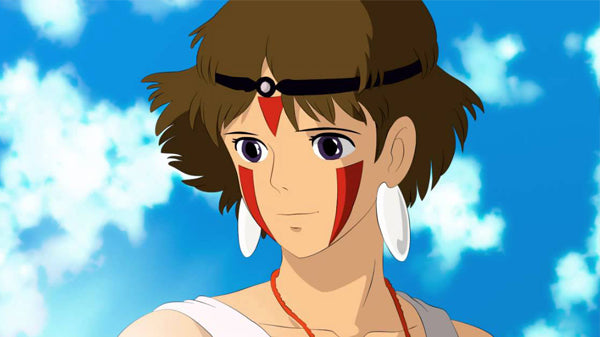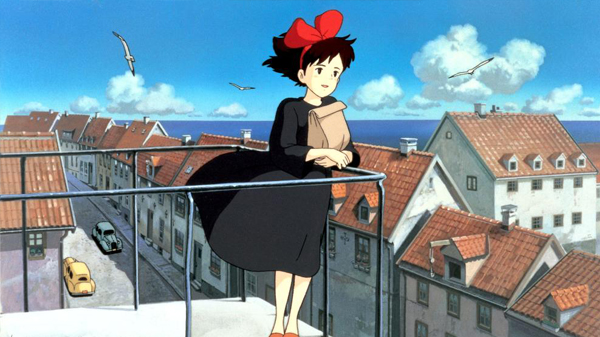Growing up with the powerful figures of femininity in Hollywood, Zoe Crombie didn’t always feel seen. But the female protagonists of Hayao Miyazaki’s films brought her a much needed kinship.
When I felt increasingly weak and less self-assured during my teenage years, I struggled to see myself in most female characters onscreen. When I looked in the mirror at my bony frame and oversized nose age 14, I’d notice tears and snot imbued with kohl eyeliner too. I didn’t find much solace in the stereotypically masculine traits – emotional distance and violent tendencies – of The Hunger Games’ Katniss Everdeen. When I began to doubt my physical value after being diagnosed with M.E., I struggled to feel empowered by Rey’s agility and stamina in The Force Awakens. As I grew up in the noughties, a century of cinematic history had already been established – with that, came several decades worth of self-sufficient female protagonists, defined by features independent to their male counterparts: the tough and resourceful Ripley from Alien; Hermione with her intelligence and sense of righteousness in the Harry Potter franchise; the quickly self-confident example set in Star Wars by Princess Leia. Maybe I could resemble these people in my stronger moments but ultimately, where some may feel lifted by the power of these characters, I felt like a half-formed person.
The first time I watched Spirited Away was at an after-school club when I was seven years old. After settling down on the musty nursery carpet, I left roughly half an hour in, when our anxiety-ridden child protagonist Chihiro is just beginning to explore the mystifying and menacing spirit world she stumbles upon. I wondered why anyone would like her – she begins the film by laying her feet up in the back of her hulking father’s ‘four-wheel drive’, complaining how she never receives flowers and sticking her tongue out mockingly at her lush surroundings. Later on, the visceral quaking fear that surges through her tiny frame as she watches her parents transform into enormous pigs clashed in my mind with the unabashed confidence of Mulan facing down an entire army. The long pans across vast landscapes, in which the tiny hero was barely a speck in the corner of the frame, made the surrealist world around her seem completely unknowable, let alone vanquishable. Chihiro made me incredibly uncomfortable – but I wouldn’t realise it until almost ten years later.
Moderate to severe M.E. ensures you have a lot of time on your hands, existing in a bedridden fog most of the day. As a teen, I read endless Wikipedia pages on directors, bought as many box sets as I could, and studied innumerable ‘Top Ten’ lists. To my surprise, Spirited Away featured prominently on most of the foreign-language and animated film lists I devoured, so I eventually decided to give it another chance – this time, until the end. Finally, something clicked: Chihiro isn’t a conventionally aspirational character, as was every other female protagonist I had seen up to that point. She seemed vulnerable, and relatable. Now, when I reflect on Chihiro’s frail physicality as she chokes down a dumpling, or the whining tone of desperation in dub actress Daveigh Chase’s voice, I feel closer to a fictional character than I ever had before. I didn’t want to be her, because I already was her.
The films of Japanese auteur Hayao Miyazaki may feature dream logic and fantastical elements, rarely explaining the specific workings of the magical facets of his stories, but every single character is ripe with emotional realism, allowing for an intense level of empathy. This is not because of unparalleled physical ability or unshakeable courage, but in the characters’ hidden interior resilience. In Kiki’s Delivery Service, the upbeat 13-year-old Kiki doesn’t slay a dragon or conquer the world, but she does independently create a life for herself in a cosy flat via her career ambitions to put her broom-flying to good use. This determination is fuelled by the other women she meets, ranging from baker and soon-to-be mother Osono and the free-spirited painter Ursula. Kiki learns to cope with the world around her, as so many women have done in generations prior.
Sophie from Howl’s Moving Castle manages to find fulfillment by creating a home and surrounding herself with a chosen family rather than a love interest. The emotional labour she is forced to undertake in terms of helping Howl overcome his cowardice doesn’t result in success only for him, but in freedom for herself. The appearance of these characters is overtly feminine: their open, soft, wide-eyed faces suggest no kind of hard-lined machismo – but it’s rarely commented upon. Sophie’s simple, billowing maxi dresses suggest a humility by gently covering her slight body, but never pose an obstacle in fighting her way through the landscape of the Waste. Kiki’s oversized black robe is traditional for witches, allowing others to categorise her as such, but the outfit is functional and does not serve to make her more attractive. Kiki dislikes it at first, but her beauty is repeatedly shown not to be of anyone’s concern but her own. Miyazaki’s drawing style adds a significant amount here, the soft lines and contours of Sophie and Kiki’s appearances suggesting a kindness, but their realistic bodily proportions reinforce a simultaneously resilient and unequivocally feminine physicality.
On the other end of the spectrum stands Princess Mononoke’s San, one of the more recognisable Ghibli women, known for her primal appearance and tendency towards violence, something that isn’t shared with other more reserved protagonists. While these more typically masculine characteristics are not vilified – her fighting prowess and barely restrained anger frequently serve her well – the end of San’s story shows a retreat to a more peaceful existence, coming to terms with the complexity of global existence and with her own personal humanity. The claim that she isn’t ‘afraid to die’ is reminiscent of the kind of self-sacrifice often seen in female characters as they perish for the sake of their male love interest; here, it is for a political cause greater than herself, stemming from a strong sense of personal injustice. The idea of running away to the woods and living unrestrained could seem enticing for some women (myself included): no more expectations on your looks, your behaviour, or your ability to make others happy. Instead of constantly ruminating on her own justified anger, San learns how to work alongside it, remaining a defiant figure of nonconformity without letting her despair rule her.
Since devouring the Ghibli filmography, I have unexpectedly become more sympathetic to the sensational women of Hollywood. Striving to harness the confidence, intelligence, and skill of the women of popular film history is certainly not a bad thing – but I’m not a ninja, I’m not a wizard, and I don’t imagine I’ll ever become an astronaut. I’m a woman who will likely live an ordinary life, writing in a domestic setting of my own making, feeling like a flesh and blood incarnation of these ink and paper girls. I am not traditionally masculine, and my conventionally feminine ability to cope and empathise has served me more than physical strength, aggression or cocky one-liners ever could. Miyazaki’s films place value on women’s most invisible labour, and I am more contented for placing value on my own in turn.
Zoe Crombie (@CrombieZoe) is a film student and critic from the North of England. Writing for Film Inquiry, The Digital Fix, and City Countdown, as well as her blog Obsess Reviews, she can be primarily found rewatching Ghibli movies and eating spaghetti.
READ ME is a platform for female-led writing on film hosted by Girls on Tops. Louisa Maycock (@louisamaycock) is Commissioning Editor and Ella Kemp (@efekemp) is Contributing Editor.



